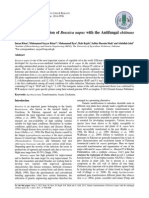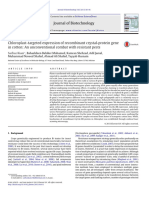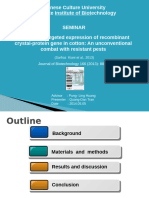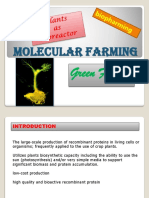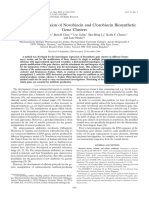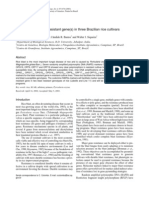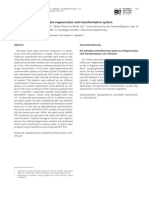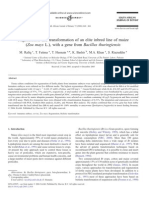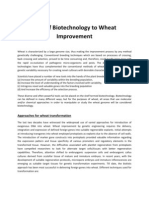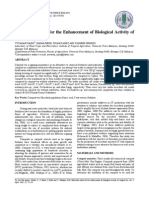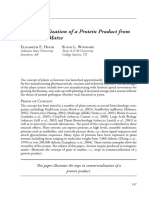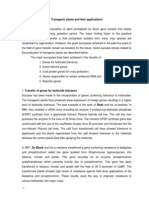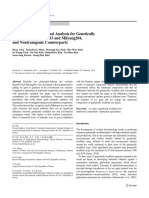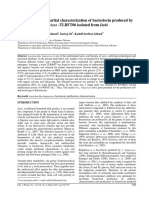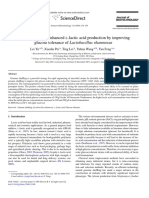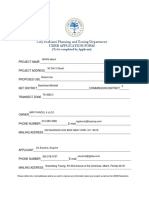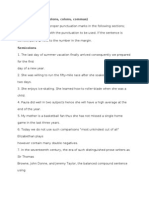Chloroplast-Targeted Expression of Synthetic Cry1ac in Transgenic Rice As An Alternative Strategy For Increased Pest Protection
Chloroplast-Targeted Expression of Synthetic Cry1ac in Transgenic Rice As An Alternative Strategy For Increased Pest Protection
Uploaded by
Claudio BrondaniCopyright:
Available Formats
Chloroplast-Targeted Expression of Synthetic Cry1ac in Transgenic Rice As An Alternative Strategy For Increased Pest Protection
Chloroplast-Targeted Expression of Synthetic Cry1ac in Transgenic Rice As An Alternative Strategy For Increased Pest Protection
Uploaded by
Claudio BrondaniOriginal Title
Copyright
Available Formats
Share this document
Did you find this document useful?
Is this content inappropriate?
Copyright:
Available Formats
Chloroplast-Targeted Expression of Synthetic Cry1ac in Transgenic Rice As An Alternative Strategy For Increased Pest Protection
Chloroplast-Targeted Expression of Synthetic Cry1ac in Transgenic Rice As An Alternative Strategy For Increased Pest Protection
Uploaded by
Claudio BrondaniCopyright:
Available Formats
Planta (2009) 230:397405 DOI 10.
1007/s00425-009-0955-x
O R I G I N A L A R T I CL E
Chloroplast-targeted expression of synthetic cry1Ac in transgenic rice as an alternative strategy for increased pest protection
Eun Hye Kim Seok Cheol Suh Beom Seok Park Kong Sik Shin Soon Jong Kweon Eun Jung Han Su-Hyun Park Youn Shic Kim Ju-Kon Kim
Received: 13 April 2009 / Accepted: 12 May 2009 / Published online: 30 May 2009 Springer-Verlag 2009
Abstract To increase insect resistance in transgenic rice plants, a synthetic truncated cry1Ac gene was linked to the rice rbcS promoter and its transit peptide sequence (tp) for chloroplast-targeted expression. Several transgenic lines were generated by the Agrobacterium-mediated transformation method and the expression levels of the transgene were compared with untargeted expression. Use of the rbcS-tp sequence increased the cry1Ac transcript and protein levels by 25- and 100-fold, respectively, with the accumulated protein in chloroplasts comprising up to 2% of the total soluble proteins. The high level of cry1Ac expression resulted in high levels of plant resistance to three common rice pests, rice leaf folder, rice green caterpillar, and rice skipper, as evidenced by insect feeding assays. Transgenic plants were also evaluated for resistance to natural infestations by rice leaf folder under Weld conditions. Throughout the entire period of plant growth, the transgenic plants showed no symptoms of damage, whereas nontransgenic control plants were severely damaged by rice leaf folders. Our results demonstrate that the targeting of cry1Ac protein to the chloroplast using the rbcS:tp system confers a high level of plant protection to insects, thus providing an alternative strategy for crop insect management.
Keywords Chloroplast targeting Insect resistance rbcS transit peptide Synthetic cry1Ac Transgenic rice Abbreviations Bt Bacillus thuringiensis LSD Least signiWcant diVerence MS Murashige and Skoog rbcS Ribulose bisphophate carboxylase small subunit Tp Transit peptide NT Nontransgenic
Introduction The generation of transgenic plants that express exogenous insecticidal proteins has shown promise for increasing plant resistance to insects and reducing the need for pesticide application (James 2007). Crystal proteins from Bacillus thuringiensis (Bt) have attracted wide attention as insecticidal molecules. Bt proteins are highly speciWc to certain species of insects and are therefore not toxic to beneWcial insects, birds, or mammals, including humans. The Bt protein acts by disrupting the midgut cells of insect pests (Bravo et al. 2007). Among the characterized insecticidal Bt proteins, cry1Ac, cry1Ab and their fusion protein are speciWcally toxic to lepidopteran insects and have therefore been used extensively to generate pest resistant transgenic plants. Stem borer insects such as the striped stem borer (Chilo suppressalis, SSB), yellow stem borer (Scirpophaga incertulas, YSB), and rice leaf folder (Cnaphalocrocis medinalis and Marasmia patnalis, RLF) are among the most threatening pests for rice crops. The germplasm of rice has a low level of resistance to these stem borers. Fortunately, Bt genes oVer enormous potential for enhancing rice resistance
E. H. Kim S.-H. Park Y. S. Kim J.-K. Kim (&) School of Biotechnology and Environmental Engineering, Myongji University, Yongin 449-728, South Korea e-mail: jukon@mju.ac.kr S. C. Suh B. S. Park K. S. Shin S. J. Kweon E. J. Han National Academy of Agricultural Sciences, Rural Development Administration, Suwon 442-707, South Korea
123
398
Planta (2009) 230:397405
to these pests (Shu et al. 2000). Insect-resistant transgenic crops expressing Bt genes have been a major biotechnological breakthrough in protecting commercial crops from damaging infestations (James 2007; Gatehouse 2008). Bt genes have been transformed into japonica and indica rice varieties, providing resistance to SSB, YSB, and RLF (Shu et al. 2000; Tu et al. 2000; Maqbool et al. 2001; Ye et al. 2001, 2003; Bashir et al. 2004). Of the known Bt genes, cry1Ab and cry1Ac have been used extensively in transgenic tomato (Kumar and Kumar 2004), cotton (Perlak et al. 1990; He et al. 2006), soybean (Dufourmantel et al. 2005), maize (Koziel et al. 1993; Meissle et al. 2005), collards (Cao et al. 2005), and rapeseed (Schuler et al. 2004). In the 1980s, several Bt genes were cloned and transferred into higher plants, but the insecticidal activity of the resulting transgenic plants was low, mainly due to mRNA degradation causing low protein expression. The creation of synthetic truncated Bt genes via deletion of the sequences irrelevant to insecticidal activity has signiWcantly increased their transgenic expression levels in plants (Barton et al. 1987; FischhoV et al. 1987; Vaeck et al. 1987). To further increase the expression of Bt genes in plants, two strategies have been employed: to insert the gene into the chloroplast genome (McBride et al. 1995; Kota et al. 1999; Liu et al. 2008) or to modify the coding sequences of the bacterial gene to plant-preferred coding sequences (Perlak et al. 1991; Sharma et al. 2000). Both approaches have proved eVective in enhancing the level of Bt expression in plants. To date, a number of studies have suggested that expression of Bt genes could improve insect resistance in rice to some extent (Bajaj and Mohanty 2005). However, despite the eVorts thus far to develop insect-resistant rice plants, few of these have been shown to be eVective under Weld conditions. Examples of positive eVects shown in the Weld conditions include transgenic rice plants expressing cry1Ab/c (Tu et al. 2000) and cry1Ab (Ye et al. 2003). The small subunit gene of the ribulose biphosphate carboxylase/oxygenase (rbcS) promoter and its transit peptide sequence (tp) provides an attractive system for targeting heterologous proteins to the chloroplasts. Previously, we observed that the targeting of foreign gene products to plastids using the rice rbcS-tp sequence increased the protein product levels in transgenic rice plants (Jang et al. 1999, 2002). In our current study, a synthetic truncated cry1Ac was linked to the rice rbcS-tp sequence for chloroplast-targeted expression. Use of the rbcS-tp sequence increased the cry1Ac transcript and protein levels dramatically. The targeted expression of cry1Ac confers a high level of resistance to the boring insect pests, rice leaf folder, rice green caterpillar, and rice skipper under laboratory conditions, and to rice leaf folder under Weld conditions.
Materials and methods Constructs and transformation of rice The rbcS:cry1Ac and rbcS:tp-cry1Ac expression vectors contain the rbcS promoter, with or without its transit peptide (tp) (Jang et al. 1999), linked to the synthetic truncated cry1Ac gene (AY126450) that was codon-optimized for rice and kindly provided by Dr. B.S. Park at the Rural Development Administration (RDA) of Korea. The vectors also contain the bar gene under the control of cauliXower mosaic virus 35S promoter for herbicide-based selection. These vectors were introduced into Agrobacterium tumefaciens LBA4404 by triparental mating. Calli initiated from the embryos of dehulled rice (Oryza sativa L. cv. Nakdong) grains were transformed by co-cultivation (Hiei et al. 1994), selected with 7 mg/L phosphinothricin, and used to regenerate transgenic plants according to the method of Jang et al. (1999). Regenerated plants were grown to maturity in the greenhouse and transgenic T14 seeds were harvested. RNA blot and immunoblot analyses Transgenic and nontransgenic (NT) seeds (Oryza sativa L. cv. Nakdong) were germinated on MS solid medium (Murashige and Skoog 1962) containing 4 mg/L phosphinothricin (3 days dark, 1 day light, 28C), transferred to Rice Nursery Media (Bio-media Co., Ltd., Kyoungju, Korea), and grown for 2 weeks. The NT (Oryza sativa L. cv. Nakdong) seeds were kindly provided by Dr. J. Y. Lee at the Rural Development Administration (RDA), Suwon, Korea. The plants were then transplanted into pots containing paddy soils according to the method of Oh et al. (2008). Total RNAs were extracted from 14-day-old leaves using Tri reagent (MRC, Inc., Cincinnati, OH, USA) according to the manufacturers protocol. RNA gel blot analysis was performed as previously described (Oh et al. 2005). For immunoblot experiments, total soluble proteins were extracted from the leaf tissues of 6-week-old plants. The extraction buVer consisted of 100 mM TrisCl, pH 8.1, 100 mM 2-mercaptoethanol, 0.1% (w/v) SDS, and 100 M phenylmethylsulphonylXuoride (PMSF). The extracts were centrifuged at 14,000g at 4C for 10 min. The chloroplastenriched fractions were prepared according to the manufacturers protocol (Chloroplast Iso Kit, SigmaAldrich, St. Louis, MO, USA). Protein concentrations were determined using the Bradford method (Bio-Rad, Hercules, CA, USA). Protein extracts were then separated on 10% SDSpolyacrylamide gels and blotted onto a polyvinylidene diXuoride (PVDF) membrane (Immobilon-P, Millipore Corporation, Billerica, MA, USA) using a semi-dry transfer apparatus (Bio-Rad). The immunoreactive proteins were detected using primary antibodies against cry1Ac (Fitzgerald
123
Planta (2009) 230:397405
399
Industries International Inc., Concord, MA, USA) and rbcL (ribulose bisphosphate carboxylase/oxygenase large subunit; Promega, Madison, WI, USA). The chemiluminescence of bound antibodies was detected by using the Pierce Super Signal Substrate (Pierce, Rockford, IL, USA) according to the manufacturers protocol. Recombinant cry1Ac proteins that were not truncated were used as a positive control (Fitzgerald Industries International Inc.). Insect bioassays under laboratory and Weld conditions Four rice lepidopteran pest species were employed in the insecticidal activity assays. These species included the rice leaf folder (Cnaphalocrocis medinalis), rice green caterpillar (Naranga aenescens), rice skipper (Parnara guttata), and armyworm (Mythimna separate). Larvae were collected from rice Welds of the RDA, Suwon, Korea. Following collection, insects were incubated in the RDA insectaria and used in the feeding bioassays under laboratory conditions. For cut-leaf feeding bioassays, a 5 cm length of leaf tissue was taken from rice plants at the grain-Wlling stage and placed in a petri dish. The leaf tissue was kept wet by placing it on two pieces of Wlter paper that were saturated with 100 mg/L benzimidazole solution. Forth- to sixth-instar larvae of leaf folder, green caterpillar, skipper, and armyworm species were observed after 4, 6, 5, and 8 days of feeding, respectively. Three independent experiments were performed using 10 larvae per experiment. Data for insecticidal activity were statistically analyzed using the least signiWcant diVerence (LSD) test. To evaluate insect resistance of transgenic and nontransgenic plants against natural rice leaf folder infestations, seeds were germinated in the greenhouse and grown for 3 weeks, and then seedlings were transplanted to a paddy Weld at the RDA, Suwon, Korea. To increase the chances of a natural outbreak of rice leaf folder, no lepidopteran-active pesticides were applied during the entire period of growth. A block design with three replicates was employed with 90 plants per block. Two months after transplantation, a total of 270 plants were examined for damage by rice leaf folder and the numbers of aVected plants per replicate and folded leaves per aVected plant were then scored. Data were obtained at 310 day-intervals from 27 July to 26 September 2005. The results from three replicate experiments were averaged for analyses.
Results Chloroplast-targeted expression of a synthetic cry1Ac in transgenic rice The components of the plasmid used for rice transformation are shown in Fig. 1a. For comparison, two expression
vectors were constructed: rbcS:cry1Ac for untargeted and rbcS:tp-cry1Ac for chloroplast-targeted expression. A total of 36 independent transgenic lines (20 rbcS:cry1Ac and 16 rbcS:tp-cry1Ac) were produced using the Agrobacteriummediated transformation method (Hiei et al. 1994). By selWng and selecting of germinating transgenic seeds on phosphinothricin-containing MS media, we obtained T4 homozygous lines and two lines for each construct that contained a single copy of the corresponding transgene were used for further analysis. Copy numbers of transgene were determined by genomic Southern-blots (Fig. 1). The strategy for Southern-blot analysis is depicted in Fig. 1a. Genomic DNAs from transgenic plants were digested with PstI, which excised a 2.6-kb DNA fragment spanning the coding region of the cry1Ac gene (Fig. 1b). The 2.6-kb DNA fragment appeared in all of the transgenic plants and thereby conWrmed that they contained at least one intact copy of the transgene. When the probe B was used, a 1.4-kb fragment corresponding to the 3 MAR region (Fig. 1c) was detected in all of the transgenic plants. In addition, the transgenic plants showed distinct band patterns (variable), which suggests that each line was generated by an independent integration event (Fig. 1c). We determined copy number of transgene by counting the number of bands in addition to 1.4-kb fragment (Fig. 1c). Lines # 1 and #2 of rbcS:tpcry1Ac plants and lines #11 and #12 of the rbcS:cry1Ac plants appeared to contain single copy of transgene. When levels of transgene expression were examined by RNA blot analysis (Fig. 1d), the levels of the cry1Ac transcripts in the rbcS:tp-cry1Ac plants were much higher than those in the rbcS:cry1Ac plants. As shown in Fig. 1d, use of the rbcS transit peptide (tp) sequence increased the cry1Ac transcript levels by 14- to 25-fold. Production of the cry1Ac protein in the four transgenic plant lines shown in Fig. 1b was determined by immunoblot analysis of extracted proteins using an anti-cry1Ac antibody (Fig. 2a). By comparing the band intensities of a series of dilutions of the protein extracts (Fig. 2a, lanes 6 and 9), we estimated that the cry1Ac levels in mature leaves of the rbcS:tp-cry1Ac plants were about 100-fold higher than those of the rbcS:cry1Ac plants. This was calculated by assuming that the band intensity of cry1Ac (63 kDa) in lane 6 of Fig. 2a (0.2 g of protein extract loaded) is equal to that in lane 9 of Fig. 2a (20 g of protein extract loaded). The cry1Ac produced also accounted for about 2% of the total soluble proteins. This was also calculated by assuming that the band intensity of cry1Ac recombinant protein (120 kDa) in lane 3 of Fig. 2b (0.02 g loaded) is equal to that of cry1Ac (63 kDa) in lane 5 of Fig. 2b (1 g of protein extract loaded). Thus, the diVerence in the cry1Ac protein levels between the rbcS:tp-cry1Ac and rbcS:cry1Ac plants was far greater than that in the corresponding transcript levels. We speculate that the
123
400
Planta (2009) 230:397405
Fig. 1 Production of transgenic rice plants. a rbcS:tp-cry1Ac consists of the rice rbcS promoter and its transit peptide (tp) sequence linked to the synthetic cry1Ac coding region, the 3 region of the potato proteinase inhibitor II gene (3 pinII), and the bar expression cassette containing a 35S promoter/bar coding region/3 region of the nopaline synthase gene (3 nos). The entire expression cassette is Xanked by 5 matrix attachment region (MAR) of the chicken lysozyme gene. BR and BL indicate borders for Agrobacterium-mediated transformation. The rbcS:cry1Ac construct is the same as the rbcS:tp-cry1Ac construct, except for the absence of tp. The restriction sites (P, PstI; RI, EcoRI), the expected fragments (intact and variable) and the hybridization probe (probe A and B) used for genomic DNA-blot analyses are shown below the map. b Genomic DNAs from leaf tissues of 9 and 4 independent lines of rbcS:tp-cry1Ac and rbcS:cry1Ac plants, respectively, and nontransgenic (NT) controls were digested with Pst1 (P) and hybrid-
ized with probe A. The DNA molecular size markers are indicated. c Genomic DNAs from leaf tissues of 5 and 4 independent lines of rbcS:tp-cry1Ac and rbcS:cry1Ac plants, respectively, and nontransgenic (NT) controls were digested with EcoRI (RI) and hybridized with probe B. The DNA molecular size markers are indicated. Filled arrowhead, 1.4 kb fragments of 3 MAR region; unWlled arrowheads, band positions corresponding to the variable regions shown in (a). d RNA blot analysis of cry1Ac in transgenic plants. Total RNAs from the leaves of rbcS:tp-cry1Ac (lines #1 and #2), rbcS:cry1Ac (lines #11 and #12), and nontransgenic (NT) plants were hybridized with the cry1Ac probe (probe A) and then reprobed with the rice rbcS gene (Jang et al. 1999). The relative expression levels (REL) of cry1Ac were calculated by dividing the band intensities of cry1Ac by those of the corresponding rbcS
123
Planta (2009) 230:397405 Fig. 2 Levels of cry1Ac protein in transgenic plants. a The indicated amounts of protein extracts from the leaves of rbcS:tp-cry1Ac (lines #1 and #2), rbcS:cry1Ac (lines #11 and #12), and nontransgenic (NT) plants were separated on a SDS-polyacrylamide gel, transferred to a membrane, and then immunoblotted with an anti-cry1Ac antibody. b The levels of cry1Ac protein in rbcS:tp-cry1Ac (line #2) plants were compared with those of a positive control (PC, recombinant non-truncated cry1Ac protein). c, d Total (T) protein extracts and chloroplast (Chl)-enriched fractions were prepared from the leaves of rbcS:tp-cry1Ac (line #2), rbcS:cry1Ac (line #12), and NT plants. The indicated amounts of protein were used for immunoblotting with either an anti-cry1Ac (c) or anti-rbcL (d) antibody. The rbcL (ribulose bisphosphate carboxylase/ oxygenase large subunit) was used as a marker for chloroplasttargeted expression. Arrows on right side of panels indicate positions of cry1Ac protein (63 kDa), recombinant non-truncated cry1Ac protein (120 kDa) and rbcL (52 kDa)
401
enhanced translation of tp-cry1Ac transcripts may account for this diVerence. Alternatively, the cry1Ac protein may be more stable in chloroplasts than in cytosolic compartments. To investigate whether the expressed cry1Ac protein was targeted to the chloroplasts, we evaluated its levels in chloroplast-enriched fractions prepared from the rbcS:tpcry1Ac and rbcS:cry1Ac plants and compared these with its levels in total cell extracts by immunoblot analysis. The levels of cry1Ac in the chloroplast-enriched fractions were higher than in the total cell extracts by about twofold only in the rbcS:tp-cry1Ac plants (Fig. 2c), reXecting enrichment of chloroplasts. The Rubisco large subunit (rbcL), a protein that is speciWcally localized in chloroplasts, showed a similar proWle in both the rbcS:tp-cry1Ac and the rbcS:cry1Ac plants (being higher in chloroplast-enriched fractions than in the total cell extracts, Fig. 2d), indicating similar amounts of protein loaded in Fig. 2c and d. These observations together suggest that cry1Ac was successfully
targeted to the chloroplasts in the rbcS:tp-cry1Ac plants. Our results demonstrate that the rbcS-tp system facilitates the accumulation of the cry1A protein in chloroplasts at a level equivalent to 2% of the total soluble proteins. Insect resistance under artiWcial laboratory conditions To examine whether the chloroplast-targeted expression of cry1Ac increased the eVective range of susceptible insects, bioassays were carried out as described in Materials and methods. The larvae that fed on nontransgenic (NT) plants grew well, whereas those fed on rbcS:tp-cry1Ac plants turned brown and showed severe growth retardation (Fig. 3). Leaf folder, green caterpillar, and skipper larvae fed on rbcS:tp-cry1Ac plants all died. Armyworms showed 20% mortality. In contrast, all larvae fed NT plants survived, indicating high levels of resistance in rbcS:tp-cry1Ac plants to leaf folder, green caterpillar, and skipper insects
123
402
Planta (2009) 230:397405
Discussion In the current study, we have shown that the rice ribulose bisphosphate carboxylase small subunit promoter-transit peptide sequence (rbcS-tp) system facilitates the accumulation of the cry1A protein in chloroplasts at a level equivalent to 2% of the total soluble proteins in transgenic rice. Despite the high levels of cry1Ac expression, we did not observe any deleterious eVects on the growth or development of the transgenic plants. Similarly high levels of expression were obtained when a truncated cryIAc was expressed in tobacco plants under the control of the Arabidopsis rbcS promoter and its transit peptide sequence (Wong et al. 1992). The fusion of cry1Ac with Arabidopsis rbcs-tp produced a 10- to 20-fold increase in both the cryIAc mRNA and protein levels, as compared with the expression driven by the CaMV 35S promoter. It thus appears that targeting of protein products to chloroplasts using rbcS-tp increases the stability of the corresponding mRNAs and the subsequent translation eYciency in both rice and tobacco. An additional advantage of using the rbcS-tp system for cry1Ac expression is that cry1Ac accumulates in the vegetative tissues and not in the grains. Most caterpillars feed on vegetative tissues that are rich in chloroplast, thereby consuming the high level of insecticidal protein. Given the high levels of cry1Ac accumulation in rbcS:tp-cry1Ac plants, the 100% mortality rate found for the three insect larvae, leaf folder, green caterpillar, and skipper insects, under laboratory conditions, was not surprising. The expression levels of cryIAb and cryIAc in the range of 0.020.05% of soluble proteins were previously shown to cause a 1050% and 7692% mortality for the striped stem borer (Fujimoto et al. 1993) and yellow stem borer (Nayak et al. 1997), respectively. In addition, toxin levels in transgenic plants of 0.10.3% of the total soluble proteins at the time of feeding have been found to be required to produce 100% mortality (Cheng et al. 1998; Datta et al. 1998; Ho et al. 2006). Leaf folder was previously shown to be controlled by the transgenic expression of cry1Ab (Fujimoto et al. 1993; Wnn et al. 1996; Ye et al. 2003) and cry1Ac (Maqbool et al. 2001; Bashir et al. 2004) in rice. The transgenic expression of cry1Ab was also found to be eVective against green caterpillar and skipper (Shu et al. 2000). In our current study, we demonstrate that the transgenic expression of cry1Ac confers a high level of resistance to green caterpillar and skipper as well as to leaf folder under laboratory conditions. Our rbcS:tp-cry1Ac plants also showed a high level of protection against natural infestation with the rice leaf folder. Transgenic rice plants expressing synthetic cry1Ab (Ye et al. 2003) and cry1Ab/c (Tu et al. 2000) have been evaluated previously for resistance to the leaf folder and showed insect resistance under Weld conditions. The
Fig. 3 Cut-leaf feeding bioassays of rbcS:tp-cry1Ac and nontransgenic (NT) plants. Forth to sixth-instar larvae of rice leaf folder, rice green caterpillar, rice skipper, and armyworm species were fed an artiWcial diet containing the cut leaves of rbcS:tp-cry1Ac (line #2) and NT plants for 48 days. Larvae fed on rbcS:tp-cry1Ac (line #2) plants appeared brown and their growth was severely retarded when compared with the larvae fed on NT plants
under laboratory conditions. Similar results were consistently observed in triplicate experiments. Insect resistance under Weld conditions To assess the insect resistance of transgenic plants under Weld conditions, we transplanted the rbcS:tp-cry1Ac and NT plants to a paddy Weld and grew them to maturity. We evaluated plants aVected by natural infestation of rice leaf folder during the 2005 growing season. Throughout the entire period of growth, the rbcS:tp-cry1Ac plants did not show any symptoms of insect damage, whereas control NT plants were severely damaged by leaf folder (Fig. 4). In the NT plants speciWcally, the percentages of aVected plants per block of 90 tested plants and aVected leaves per plant ranged from 5.6 to 29.8% and from 0.3 to 3.4%, respectively, depending on the stages of examination (Fig. 5). Thus, our rbcS:tp-cry1Ac plants showed a high level of protection against natural infestation with the rice leaf folder.
123
Planta (2009) 230:397405 Fig. 4 Appearance of rbcS:tpcry1Ac and NT plants grown in a paddy Weld with a natural infestation of rice leaf folder insects. NT plants were severely aVected by the rice leaf folders, whereas rbcS:tp-cry1Ac (line #2) plants were highly resistant. Lower panels depict leaf folders sitting on the leaves of rbcS:tp-cry1Ac (line #2, right) and NT (left) plants
403
Fig. 5 Percentage of aVected plants and leaves after natural infestation by rice leaf folder insects under Weld conditions. Three blocks with 90 plants per block were transplanted and examined for damage caused by rice leaf folders at 310 day intervals from July to September 2005. The number of aVected plants per block and the number of aVected leaves per aVected plant were scored and averaged. Values are the mean SD (n = 90). Solid lines, nontransgenic (NT) plants; grey lines, rbcS:tp-cry1Ac (line #2) plants. Recording dates (M/D, month/ day) are indicated
percentage of plants aVected by natural outbreaks of leaf folder in the case of cry1Ab/c transgenics was in the range of 1218% (Tu et al. 2000). The relatively low level of protection appears to be due to the low level of cry1Ab/c expression (0.002% of total soluble protein). Throughout
the entire period of growth in Weld conditions, our rbcS:tpcry1Ac plants did not show any symptoms of insect damage, while control NT plants were severely damaged by leaf folder. Thus, our current study demonstrates that the targeting of cry1Ac proteins to chloroplasts using the rbcS:tp
123
404
Planta (2009) 230:397405 yellow stem borer in transgenic elite vietnamese rice (Oryza sativa L.) cultivars. Crop Sci 46:781789 James C (2007) Global status of commercialized biotech/GM crops: 2007. ISAAA Briefs No. 37. ISAAA, Ithaca, NY Jang I-C, Nahm BH, Kim J-K (1999) Subcellular targeting of green Xuorescent protein to plastids in transgenic rice plants provides a high-level expression system. Mol Breed 5:453461 Jang I-C, Lee K-H, Nahm BH, Kim J-K (2002) Chloroplast targeting signal of a rice rbcS gene enhances transgene expression. Mol Breed 9:8191 Kota M, Daniell H, Varma S, Garczynski SF, Gould F, Moar WJ (1999) Overexpression of the Bacillus thuringiensis (Bt) Cry2Aa2 protein in chloroplasts confers resistance to plants against susceptible and Bt-resistant insects. Proc Natl Acad Sci USA 96:18401845 Koziel MG, Beland GL, Bowman C, Carozzi NB, Crenshaw R, Crossland L, Dawson J, Desai N, Hill M, Kadwell S, Lauris K, Lewis K, Maddox D, McPherson K, Meghji MR, Merlin E, Rhodes R, Warren GW, Wright M, Evola SV (1993) Field performance of elite transgenic maize plants expressing an insecticidal protein derived from Bacillus thuringiensis. Bio Technol 11:194200 Kumar H, Kumar V (2004) Tomato expressing Cry1A(b) insecticidal protein from Bacillus thuringiensis protected against tomato fruit borer, Helicoverpa armigera (Hbner) (Lepidoptera: Noctuidae) damage in the laboratory, greenhouse and Weld. Crop Protect 23:135139 Liu CW, Lin CC, Yiu JC, Chen JJW, Tseng MJ (2008) Expression of a Bacillus thuringiensis toxin (cry1Ab) gene in cabbage (Brassica oleracea L. var. capitata L.) chloroplasts confers high insecticidal eYcacy against Plutella xylostella. Theor Appl Genet 117:7588 Maqbool SB, Riazuddin S, Loc NT, Gatehouse AMR, Gatehouse JA, Christou P (2001) Expression of multiple insecticidal genes confers broad resistance against a range of diVerent rice pests. Mol Breed 7:8593 McBride KE, Svab Z, Schaaf DJ, Hogan PS, Stalker DM, Maliga P (1995) AmpliWcation of a chimeric Bacillus gene in chloroplasts leads to an extraordinary level of an insecticidal protein in tobacco. Bio Technol 13:362365 Meissle M, Vojtech E, Poppy GM (2005) EVects of Bt maize-fed prey on the generalist predator Poecilus cupreus L. (Coleoptera: Carabidae). Transgenic Res 14:123132 Murashige T, Skoog F (1962) A revised medium for rapid growth and bioassays with tobacco tissue culture. Physiol Plant 15:473497 Nayak P, Basu D, Das S, Basu A, Ghosh D, Ramakrishnan NA, Ghosh M, Sen SK (1997) Transgenic elite indica rice plants expressing cry1Ac -endotoxin of Bacillus thuringiensis are resistant against yellow stem borer (Scirpophaga incertulas). Proc Natl Acad Sci USA 94:21112116 Oh SJ, Song SI, Kim YS, Jang HJ, Kim SY, Kim M, Kim YK, Nahm BH, Kim JK (2005) Arabidopsis CBF3/DREB1A and ABF3 in transgenic rice increased tolerance to abiotic stress without stunting growth. Plant Physiol 138:341351 Oh SJ, Kim SJ, Kim YS, Park SH, Ha SH, Kim JK (2008) Arabidopsis cyclin D2 expressed in rice forms a functional cyclin-dependent kinase complex that enhances seedling growth. Plant Biotechnol Rep 2:227231 Perlak FJ, Deaton RW, Armstrong TA, Fuchs RL, Sims SR, Greenplate JT, FischhoV DA (1990) Insect resistant cotton plants. Bio Technol 8:939943 Perlak FJ, Fuchs RL, Dean DA, McPherson SL, FischhoV DA (1991) ModiWcation of the coding sequence enhances plant expression of insect control protein genes. Proc Natl Acad Sci USA 88:3324 3328 Schuler TH, Denholm I, Clark SJ, Stewart CN, Poppy GM (2004) EVects of Bt plants on the development and survival of the parasitoid Cotesia plutellae (Hymenoptera: Braconidae) in susceptible
system provides an alternative method for a high level of crop protection under both laboratory and Weld conditions. Further applications of this system using other Bt genes will potentially be of great assistance in the establishment of future insect management strategies for rice and other important crops.
Acknowledgments This work was supported by the Ministry of Education, Science and Technology, Korea, through the Crop Functional Genomics Center (CG2111 to J.-K.K. and CG2141 to S.C.S) and by the Biogreen21 Program (grant to J.-K.K.) and National Academy of Agricultural Sciences (Code number 200901FHT020508369), Rural Development Administration of Korea.
References
Bajaj S, Mohanty A (2005) Recent advances in rice biotechnologytowards genetically superior transgenic rice. Plant Biotechnol J 3:275307 Barton KA, Whiteley HR, Yang N-S (1987) Bacillus thuringiensis -endotoxin expressed in transgenic Nicotiana tabacum provides resistance to Lepidopteran insects. Plant Physiol 85:11031109 Bashir K, Husnain T, Fatima T, Latif Z, Mehdi SA, Riazuddin S (2004) Field evaluation and risk assessment of transgenic indica basmati rice. Mol Breed 13:301312 Bravo A, Gill SS, Sobern M (2007) Mode of action of Bacillus thuringiensis Cry and Cyt toxin and their potential for insect control. Toxicon 49:423435 Cao J, Shelton AM, Earle ED (2005) Development of transgenic collards (Brassica oleracea L., var. acephala) expressing a cry1Ac or cry1C Bt gene for control of the diamondback moth. Crop Prot 24:804813 Cheng X, Sardana R, Kaplan H, Altosaar I (1998) Agrobacteriumtransformed rice plants expression synthetic cryIA(b) and cryIA(c) genes are highly toxic to striped stem borer and yellow stem borer. Proc Natl Acad Sci USA 95:27672772 Datta K, Vasquez A, Tu J, Torrizo L, Alam MF, Oliva N, Abrigo E, Khush GS, Datta SK (1998) Constitutive and tissue-speciWc diVerential expression of the cry1A(b) gene in transgenic rice plants conferring resistance to rice insect pest. Theor Appl Genet 97:2030 Dufourmantel N, Tissot G, Goutorbe F, Garon F, Muhr C, Jansens S, Pelissier B, Peltier G, Dubald M (2005) Generation and analysis of soybean plastid transformants expressing Bacillus thuringiensis Cry1Ab protoxin. Plant Mol Biol 58:659668 FischhoV DA, Bowdish KS, Perlak FJ, Marrone PG, McCormick SM, Niedermeyer JG, Dean DA, Kusano-Kretzmer K, Mayer EJ, Rochester DE, Rogers SG, Fraley RT (1987) Insect tolerant transgenic tomato plants. Bio Technol 5:807813 Fujimoto H, Itoh K, Yamamoto M, Kyozuka J, Shimamoto K (1993) Insect resistant rice generated by introduction of a modiWed endotoxin gene of Bacillus thuringiensis. Bio Technol 11:1151 1155 Gatehouse JA (2008) Biotechnological prospects for engineering insect-resistant plants. Plant Physiol 146:881887 He K, Wang Z, Bai S, Zheng L, Wang Y, Cui H (2006) EYcacy of transgenic Bt cotton resistance to the Asian corn borer (Lepidoptera: Crambidae). Crop Prot 25:167173 Hiei Y, Ohta S, Komari T, Kumashiro T (1994) EYcient transformation of rice (Oryza sativa L.) mediated by Agrobacterium and sequence analysis of the boundaries of the T-DNA. Plant J 6:271282 Ho NH, Baisakh N, Oliva N, Datta K, Frutos R, Datta SK (2006) Translational fusion hybrid bt genes confer resistance against
123
Planta (2009) 230:397405 and Bt-resistant larvae of the diamondback moth, Plutella xylostella (Lepidoptera: Plutellidae). J Insect Physiol 50:435443 Sharma HC, Sharma KK, Seetharama N, Ortiz R (2000) Prospects for using transgenic resistance to insects in crop improvement. Electron J Biotechnol 3:120 Shu Q, Ye G, Cui H, Cheng X, Xiang Y, Wu D, Gao M, Xia Y, Hu C, Sardana R, Altosaar I (2000) Transgenic rice plants with a synthetic cry1Ab gene from Bacillus thuringiensis were highly resistant to eight lepidopteran rice pest species. Mol Breed 6:433439 Tu J, Zhang G, Datta K, Xu C, He Y, Zhang Q, Khush GS, Datta SK (2000) Field performance of transgenic elite commercial hybrid rice expressing Bacillus thuringiensis -endotoxin. Nat Biotechnol 18:11011104 Vaeck M, Reynaerts A, Hfte H, Jansens S, De Beuckeleer M, Dean C, Zabean M, Van Montagu M, Leemans J (1987) Transgenic plants protected from insect attack. Nature 328:3337 Wong EY, Hironaka CM, FischhoV DA (1992) Arabidopsis thaliana small subunit leader and transit peptide enhance the expression of
405 Bacillus thuringiensis proteins in transgenic plants. Plant Mol Biol 20:8193 Wnn J, Klti A, Burkhardt PK, Biswas GCG, Launis K, Iglesia VA, Potrykus I (1996) Transgenic indica rice breeding line IR58 expressing a synthetic cry1A(b) gene from Bacillus thuringiensis provides eVective insect pest control. Bio Technol 14:171176 Ye GY, Shu QY, Yao HW, Cui HR, Cheng XY, Hu C, Xia YW, Gao MW, Altosaar I (2001) Field evaluation of resistance of transgenic rice containing a synthetic cry1Ab gene from Bacillus thuringiensis Berliner to two stem borers. J Econ Entomol 94:271276 Ye GY, Yao HW, Shu QY, Cheng X, Hu C, Xia YW, Gao MW, Altosaar I (2003) High levels of stable resistance in transgenic rice with a cry1Ab gene from Bacillus thuringiensis Berliner to rice leaYlder, Cnaphalocrocis medinalis (Guene) under Weld conditions. Crop Protect 22:171178
123
You might also like
- Survival and ThrivalDocument488 pagesSurvival and ThrivalCoralieKoonceNo ratings yet
- ICE Tower Marketing and Project Technical Briefing Final May 13, 2022Document43 pagesICE Tower Marketing and Project Technical Briefing Final May 13, 2022Raab HizonNo ratings yet
- Tender Documents 01 1. Technical Specification 2. Bill of Quantities 3. Drawings For LandscapeDocument47 pagesTender Documents 01 1. Technical Specification 2. Bill of Quantities 3. Drawings For LandscapeSherill BuenaobraNo ratings yet
- tmpF9A4 TMPDocument6 pagestmpF9A4 TMPFrontiersNo ratings yet
- Rapid Transient Expression of Cholera Toxin B Subunit (CTB) in Nicotiana BenthamianaDocument7 pagesRapid Transient Expression of Cholera Toxin B Subunit (CTB) in Nicotiana Benthamianajkz8zpbpvbNo ratings yet
- 299 2003 Article 682Document9 pages299 2003 Article 682Camille RoaquinNo ratings yet
- Paper Dan(.PDF)Document9 pagesPaper Dan(.PDF)Quang Dan TranNo ratings yet
- Plant Molecular Farming For Recombinant Therapeutic ProteinsDocument61 pagesPlant Molecular Farming For Recombinant Therapeutic Proteinsnitin_star2010No ratings yet
- Presentation(.ppt)Document34 pagesPresentation(.ppt)Quang Dan TranNo ratings yet
- tmpD66C TMPDocument9 pagestmpD66C TMPFrontiersNo ratings yet
- tmp42B7 TMPDocument9 pagestmp42B7 TMPFrontiersNo ratings yet
- Molecular FarmingDocument20 pagesMolecular FarmingVeerendra Singh NagoriaNo ratings yet
- Badenhorst2018 FructanosDocument13 pagesBadenhorst2018 FructanosPablo Peralta RoaNo ratings yet
- Eustaqio 2005 AntibioticsDocument8 pagesEustaqio 2005 AntibioticsXimena CortesNo ratings yet
- E Cient Method of Agrobacterium-Mediated Transformation For Triticale (X Triticosecale Wittmack)Document10 pagesE Cient Method of Agrobacterium-Mediated Transformation For Triticale (X Triticosecale Wittmack)Juan Carlos MontielNo ratings yet
- ARTICLE 4 An Efficient Agrobacterium Tumefaciens Mediated TransformationDocument14 pagesARTICLE 4 An Efficient Agrobacterium Tumefaciens Mediated Transformationyacinechinwi33No ratings yet
- (2015) Paenibacilluspuernese Sp. Nov., A Β-glucosidase-producing Bacterium Isolated From Pu'Er TeaDocument7 pages(2015) Paenibacilluspuernese Sp. Nov., A Β-glucosidase-producing Bacterium Isolated From Pu'Er TeaLeonardo LopesNo ratings yet
- Diverse Family of Serine Proteinase Genes Expressed in Cotton Boll Weevil (Anthonomus Grandis) Implications For The Design of Pest Resistant Transgenic Cotton PlantsDocument16 pagesDiverse Family of Serine Proteinase Genes Expressed in Cotton Boll Weevil (Anthonomus Grandis) Implications For The Design of Pest Resistant Transgenic Cotton PlantsMuhammad Subchi Wira PutratamaNo ratings yet
- B. GinsenosoiliDocument5 pagesB. GinsenosoiliEl-Agamy ProbeNo ratings yet
- tmpEBF2 TMPDocument10 pagestmpEBF2 TMPFrontiersNo ratings yet
- A Simple and Effi Cient Agrobacterium-Mediated Procedure For Transformation of TomatoDocument11 pagesA Simple and Effi Cient Agrobacterium-Mediated Procedure For Transformation of TomatoRodrigo ParolaNo ratings yet
- 1 s2.0 S0885576522000492 MainDocument7 pages1 s2.0 S0885576522000492 MainGenaina CristofoliNo ratings yet
- Sandhu 2003 SCARDocument4 pagesSandhu 2003 SCARLuiz Melgaço BloisiNo ratings yet
- Bot513 03Document8 pagesBot513 03Ponechor HomeNo ratings yet
- Saini2014 Article ElicitorsSAAndMJEnhanceCarotenDocument10 pagesSaini2014 Article ElicitorsSAAndMJEnhanceCarotenrachiiidaNo ratings yet
- TomattoDocument8 pagesTomattoashique.graspNo ratings yet
- Regeneration and Transformation of An Elite Inbred Line of Maize (Zea Mays L.), With A Gene From Bacillus ThuringiensisDocument7 pagesRegeneration and Transformation of An Elite Inbred Line of Maize (Zea Mays L.), With A Gene From Bacillus ThuringiensisCitlalli CedilloNo ratings yet
- (Main) Genetic Engineering Lab Report Part 2 - Group 2Document17 pages(Main) Genetic Engineering Lab Report Part 2 - Group 2catarina alexandriaNo ratings yet
- 2020 - Guo - Oligosaccharadide TMVDocument7 pages2020 - Guo - Oligosaccharadide TMVandreeboneNo ratings yet
- An Efficient Agrobacterium-Mediated Transformation Protocol For Black Pepper (Piper Nigrum L.) Using Embryogenic Mass As ExplantDocument8 pagesAn Efficient Agrobacterium-Mediated Transformation Protocol For Black Pepper (Piper Nigrum L.) Using Embryogenic Mass As ExplantIman Fadhul HadiNo ratings yet
- Enhanced Foreign Protein Accumulation in Nicotiana Benthamiana Leaves Co-Infiltrated With A TMV Vector and Plant Cell Cycle Regulator GenesDocument7 pagesEnhanced Foreign Protein Accumulation in Nicotiana Benthamiana Leaves Co-Infiltrated With A TMV Vector and Plant Cell Cycle Regulator Geneszhaoyue12112001No ratings yet
- WHITE OYSTER MUSHROOM (Pleurotus Florida) Mutant With Altered Antioxidant ContentsDocument8 pagesWHITE OYSTER MUSHROOM (Pleurotus Florida) Mutant With Altered Antioxidant ContentsAKNo ratings yet
- Mehmeti Et Al, 2011Document8 pagesMehmeti Et Al, 2011olindacabralNo ratings yet
- Cloning of Epra1 Gene of Aeromonas Hydrophila In: Lactococcus LactisDocument6 pagesCloning of Epra1 Gene of Aeromonas Hydrophila In: Lactococcus LactisDeri Afrizal FajriNo ratings yet
- 15 Ijasrfeb201715Document6 pages15 Ijasrfeb201715TJPRC PublicationsNo ratings yet
- Efficient Recovery of Transgenic Plants Through Organogenesis and Embryogenesis Using A Cryptic Promoter To Drive Marker Gene ExpressionDocument7 pagesEfficient Recovery of Transgenic Plants Through Organogenesis and Embryogenesis Using A Cryptic Promoter To Drive Marker Gene ExpressionAfandynibandera AfandynibanderaNo ratings yet
- Evaluating The Five Escherichia Coli Derivative Strains As Platform For Arginine Deiminase OverproductionDocument15 pagesEvaluating The Five Escherichia Coli Derivative Strains As Platform For Arginine Deiminase OverproductionTrân LâmNo ratings yet
- Improving The Expression of A Heterologous Protein by Genome Shuffling inDocument6 pagesImproving The Expression of A Heterologous Protein by Genome Shuffling inNatalia Andrea Gómez RaveNo ratings yet
- 3337Document16 pages3337dr_waelelsayed7519No ratings yet
- Final Draft of Assignment 97-03Document6 pagesFinal Draft of Assignment 97-03Rizwan AnwarNo ratings yet
- Expression of Anthocyanins and Proanthocyanidins After Transformation of Alfalfa With Maize LCDocument16 pagesExpression of Anthocyanins and Proanthocyanidins After Transformation of Alfalfa With Maize LC10sgNo ratings yet
- Microbial Starter For The Enhancement of Biological Activity of Compost TeaDocument6 pagesMicrobial Starter For The Enhancement of Biological Activity of Compost TeaGary L. NicholsNo ratings yet
- Agrobacterium-Mediated Genetic Transformation of BPT-5204, A CommerciallyDocument3 pagesAgrobacterium-Mediated Genetic Transformation of BPT-5204, A Commerciallyme_dayakarNo ratings yet
- CommercializationofaProteinProductfrom T PDFDocument12 pagesCommercializationofaProteinProductfrom T PDFvikashvermaiitkgpNo ratings yet
- Transgenic Plants and Their ApplicationsDocument18 pagesTransgenic Plants and Their ApplicationshlllvNo ratings yet
- Genetic transformation of an elite commercial wheat variety through Agrobacterium tumefaciensDocument8 pagesGenetic transformation of an elite commercial wheat variety through Agrobacterium tumefaciensOpenaccess Research paperNo ratings yet
- Molecular Analysis of Genetic Fidelity in Cannabis SativaDocument6 pagesMolecular Analysis of Genetic Fidelity in Cannabis SativaLeonardo ArellanoNo ratings yet
- Acercamientos y Distancias Entre Las ConDocument12 pagesAcercamientos y Distancias Entre Las Consanchemonica66No ratings yet
- GC Analiza 2Document7 pagesGC Analiza 2vlad valuNo ratings yet
- logiciel de prediction 2018_MBDocument19 pageslogiciel de prediction 2018_MByosraNo ratings yet
- Sem IV Chlo Trans Insect Herbicide Aviral MishraDocument33 pagesSem IV Chlo Trans Insect Herbicide Aviral Mishrawww.aviralmishra23No ratings yet
- Original Article Microencapsulation of Lactobacillus Acidophilus ATCC 43121 With Prebiotic Substrates Using A Hybridisation SystemDocument9 pagesOriginal Article Microencapsulation of Lactobacillus Acidophilus ATCC 43121 With Prebiotic Substrates Using A Hybridisation SystemMay MolinaNo ratings yet
- Lechuga TransgenicaDocument13 pagesLechuga TransgenicaJuliánMolgutNo ratings yet
- YangDocument8 pagesYangOana MîrzanNo ratings yet
- Comparative Nutritional Analysis For Genetically Modified Rice, Iksan483 and Milyang204, and Nontransgenic CounterpartsDocument8 pagesComparative Nutritional Analysis For Genetically Modified Rice, Iksan483 and Milyang204, and Nontransgenic CounterpartssharlineNo ratings yet
- A Discussion On Maize Transformation During The Last Two Decades (2002-2022) : An Update On Present Trends and Future ProspectsDocument10 pagesA Discussion On Maize Transformation During The Last Two Decades (2002-2022) : An Update On Present Trends and Future ProspectsAdvances in Agriculture and BiologyNo ratings yet
- gmr849Document8 pagesgmr849tanvir01878737666No ratings yet
- 121Document13 pages121nvduong41No ratings yet
- tmp7787 TMPDocument7 pagestmp7787 TMPFrontiersNo ratings yet
- Yu 2008Document6 pagesYu 2008nina hasanaNo ratings yet
- sreeramulu_2007Document8 pagessreeramulu_2007Deniz KarasuNo ratings yet
- Genome Size and Genetic Homogeneity of Regenerated Plants: Methods and ApplicationsFrom EverandGenome Size and Genetic Homogeneity of Regenerated Plants: Methods and ApplicationsNo ratings yet
- 12347853Document104 pages12347853konrajNo ratings yet
- Dirk Hartog Island MapDocument1 pageDirk Hartog Island MapmonyetgilasekaliNo ratings yet
- General Gymnastics Level 2 Skills MatrixDocument1 pageGeneral Gymnastics Level 2 Skills MatrixJeyomNo ratings yet
- City of Miami Planning and Zoning Department Udrb Application FormDocument2 pagesCity of Miami Planning and Zoning Department Udrb Application Formthe next miamiNo ratings yet
- SY0-401 Exam QuestionsDocument6 pagesSY0-401 Exam Questionsprestonjohn100% (1)
- JavaFX CalculatorDocument7 pagesJavaFX CalculatorAyano BoresaNo ratings yet
- Trek Fuel 70Document93 pagesTrek Fuel 70Narcis DobosNo ratings yet
- Epoxy Resin ManufactureDocument17 pagesEpoxy Resin Manufactureradhika khannaNo ratings yet
- Vision IAS Prelims 2020 Test 10 SolutionDocument19 pagesVision IAS Prelims 2020 Test 10 Solutionsachin saurabhNo ratings yet
- Company Vehicle PolicyDocument16 pagesCompany Vehicle PolicyHR100% (1)
- Home Work 25Document6 pagesHome Work 25khanh KhoaNo ratings yet
- Punctuation Commas, Semicolons, ColonsDocument3 pagesPunctuation Commas, Semicolons, ColonsmostankyNo ratings yet
- Investor Attitudes and Behavior Towards Inherent Risk and Potential ReturnsDocument13 pagesInvestor Attitudes and Behavior Towards Inherent Risk and Potential ReturnsMJaya19No ratings yet
- Seminar On Kothari COMMISSION (1964-66)Document15 pagesSeminar On Kothari COMMISSION (1964-66)Anand raj Raja BabuNo ratings yet
- Tatva Case Study 2020Document13 pagesTatva Case Study 2020ANKITA KESHARINo ratings yet
- Irr Ra 9266Document24 pagesIrr Ra 9266HegXxNo ratings yet
- CTE Endorsement Requirements Sy23-24Document9 pagesCTE Endorsement Requirements Sy23-24Farly Jean LumayaNo ratings yet
- Lecture 4Document25 pagesLecture 4Purushotham BeerakaNo ratings yet
- Share 'Kalinga PPT - PPTX'Document46 pagesShare 'Kalinga PPT - PPTX'maryjoydoles2415No ratings yet
- How To Build A REST Web API On A Raspberry PI in JavaScriptDocument11 pagesHow To Build A REST Web API On A Raspberry PI in JavaScriptJhordy Huaman OlleroNo ratings yet
- Performance Analysis of A Flexible Manufacturing System: A Statistical ApproachDocument13 pagesPerformance Analysis of A Flexible Manufacturing System: A Statistical ApproachAmrik SinghNo ratings yet
- FINAL_528_ICS2024Document6 pagesFINAL_528_ICS2024n.abdussamieNo ratings yet
- DexpanthenolDocument2 pagesDexpanthenolArtem KulikovNo ratings yet
- Challenges of Advanced Metering InfrastructureDocument7 pagesChallenges of Advanced Metering InfrastructureAlvaro Jose BazurtoNo ratings yet
- Pages From SSP 992803 Audi Dynamic SteeringDocument4 pagesPages From SSP 992803 Audi Dynamic SteeringKemNo ratings yet
- Vicente Part 2Document4 pagesVicente Part 2Fansclub TVNo ratings yet
- Report: Weldon-Breit-Wigner Formula I: (Dated: March 16, 2016)Document15 pagesReport: Weldon-Breit-Wigner Formula I: (Dated: March 16, 2016)Masoud ShokriNo ratings yet



